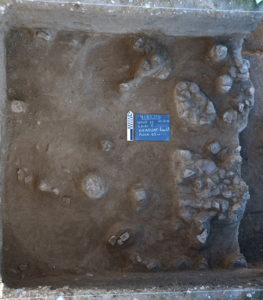 Charcoal from a rock hearth feature at Kemosabe is 7280 to 7420 years old based on C14 radiocarbon dating (calibrated). We have discovered 12 other rock hearths and four larger middens at the site, some also having charcoal, however this latest hearth had the best quality charcoal AND an associated dart point!
Charcoal from a rock hearth feature at Kemosabe is 7280 to 7420 years old based on C14 radiocarbon dating (calibrated). We have discovered 12 other rock hearths and four larger middens at the site, some also having charcoal, however this latest hearth had the best quality charcoal AND an associated dart point!
Although initially thought to be a “Martindale” , further examination as well as the radiocarbon date suggests that the dart point is a Bandy, whose style was popular in Central Te xas 6,000 to 8,000 years ago. The first pyramids in Egypt are thought to have been built 4,600 years ago, so this Bandy point is almost twice as old as the Egyptian pyramids.
xas 6,000 to 8,000 years ago. The first pyramids in Egypt are thought to have been built 4,600 years ago, so this Bandy point is almost twice as old as the Egyptian pyramids.
After four years of excavation work at the Kemosabe site we have discovered over 100 projectile points, representing 21 dart point types or styles and one arrow point type. Also discovered were 232 bifaces, 68 cores, 18 ground or pecked stone tools and 54,000 flakes—most of the flakes are debitage (waste flakes) produced when the occupants knapped chert tools and projectile points.
Only a small portion of the total Kemosabe site has been excavated but future excavations will, among other things, focus on pushing the site occupation farther back in time to yield calibrated C14 dates earlier than this first one.

